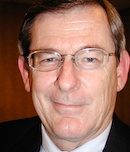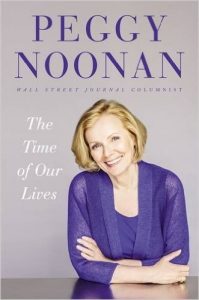
Book Review: “The Time of Our Lives”
Peggy Noonan is widely and justifiably known for her brilliant series of columns in the Wall Street Journal. She has been writing these columns for the past 15 years, and regular readers have found them to be elegantly written, well thought-out and extraordinarily clear in their messages.

Now Noonan has compiled the “best” of her columns – along with certain other writings over the years – into a highly enjoyable and well-worth-the-read book, “The Time of Our Lives.” It is a collection that exemplifies the best efforts of one of this nation’s finest conservative minds – and those efforts have been very good, indeed.
Noonan began her professional career after graduating from Farleigh Dickinson University in 1974. Her first job was at a CBS-owned radio station in Boston, and three years later she moved to CBS Radio News in New York City.
She was a news “gatherer,” editor and producer – first of local newscasts in Boston – then of network newscasts and essays in New York. Then, in the 1980’s, she became a speechwriter for President Ronald Reagan.
She gives full credit for her evolution as a writer and thinker to her CBS days, where she was taught by the “Murrow boys” – who, along with the legendary Edward R. Murrow, “invented” broadcast journalism during and after World War II.
 Noonan got to work alongside Eric Sevareid, Winston Burdett, Richard C. Hottelet, Dallas Townsend and Douglas Edwards. As she describes it: “They went over my copy, x-d out the mess of a second sentence, connected the first with the third, made it all mean something important. And in time, with their guidance and almost by osmosis, I learned a great craft.”
Noonan got to work alongside Eric Sevareid, Winston Burdett, Richard C. Hottelet, Dallas Townsend and Douglas Edwards. As she describes it: “They went over my copy, x-d out the mess of a second sentence, connected the first with the third, made it all mean something important. And in time, with their guidance and almost by osmosis, I learned a great craft.”
She tells a wonderful story about what she learned from another CBS great, Charles Osgood – who now anchors CBS’ “Sunday Morning” newscast and who has long done essays for CBS Radio. It was in 1980 – after the Mount St. Helens volcano in Washington State erupted.
Noonan was getting and recording interviews for the radio network’s newscasts when one of her interview subjects mentioned long lines at a post office near the volcano. Those lines, he said, were caused because everyone in town was picking up volcanic ash and putting it into envelopes and mailing it to their friends. The ash was slipping out of the envelopes and clogging the post office machines.
Noonan thought that was a cute anecdote but not one worthy of a network radio newscast. But when she told her anchor, Osgood, about it, he instructed her not only to use it but to put it at the top of the story. The reason, Osgood explained, was that it said a lot about the mood around Mount St. Helens. It indicated the immediate emergency was over and that human nature had kicked in. Small details, Osgood said, add up to big pictures. It was a lesson that has stayed with Noonan to this day, and which she repeatedly and brilliantly illustrates in her columns.
The chapter headings in “The Time of Our Lives” give general indications about the essays that follow. In “People I Miss,” Noonan writes movingly about the lives and deaths of Jackie Kennedy (“She was the last link to a certain kind of past, and that is part, but only part, of why we mourn so,” Tennessee Williams, who “never sold out, and he didn’t check out early. He got up every morning and wrote,” Margaret Thatcher (“She was eloquent, stirring and had tons of guts. And of course she was a woman,” and, of course, President Reagan (“He was dying for years and the day came and somehow it came as a blow.”
Noonan has collected her best columns under such other titles as “Making Trouble,” “What I Told the Bishops,” “War,” “I Just Called to Say I Love You” (about the 911 attacks), “The Loneliest President Since Nixon” (no hints here, about who that is), “A Republic, If We Can Keep It” and “State of the Union.” Her essays show her to be, yes, an elegant writer, a precise writer, a writer for whom every sentence means what it says and says what she means, and nothing more or less.
Every one of her pieces made me think. Some made me laugh out loud. And some brought tears – none more so than her exposition of how she came to write the speech President Reagan delivered on that tragic day in 1986 when the space shuttle Challenger exploded. Noonan somehow remembered a poem she had learned in junior high school – in which the author spoke of the sensation of breaking free from gravity, breaking “the surly bonds of earth,” going upward so high that he felt almost as if he could touch the face of God.
The president read it to a nation in shock and grieving over the loss of life of those seven Challenger crew members: “We will never forget them, nor the last time we saw them – this morning as they prepared for their journey and waved good-bye, and ‘slipped the surly bonds of earth’ to ‘touch the face of God.’” It was one of Reagan’s finest moments – it left the nation in tears – and it was one of the best speeches ever written, under intense deadline pressure.
Peggy Noonan did that. As she later told students at Harvard University about that day: “Sometimes, and I’m not sure it happens more than half a dozen times in a professional life, you will have a day, or a week, or a moment, or a season, when you get to think to yourself, ‘This is why I’m here. This is why I’m in this office on this day. This is why God put me here.’ I had one of those days that day. And when you have that day, that is a great day. You will never forget it.”
And, dear reader, you will never forget this book. You don’t have to be a conservative, or a believer in any particular branch of American political thought, to appreciate Peggy Noonan’s essays. You simply have to like excellent writing – and there’s plenty of that here.
